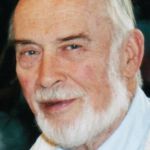Bruce R. McGarvey

Bruce R. McGarvey
Competition: US & Canada
Polytechnic Institute of Brooklyn
My career in chemistry was exciting and productive with major ups and downs. I entered Carleton College in 1946 at the end of the Second World War. In 1950 I started graduate school at the University of Illinois and, fortunately, choose Herbert Gutowsky (himself a Guggenheim Fellow in Chemistry, 1954) as my Ph.D. supervisor. He was just starting to investigate the uses of Nuclear Magnetic Resonance (NMR) in chemistry. In the three years I was there the group investigated, for the first time, the chemical shift of hydrogen, fluorine(19), phosphorous(31) and thallium(203, 205). The spin-spin and chemical exchange interactions were discovered and explained during the same period. I was one of four co-authors of the first NMR paper in JACS. It was a time when anything you did was new and publishable. One Saturday afternoon, Gutowsky and I went in the laboratory and measured the ratio of the NMR frequency of thallium isotopes 203 and 205 to a precision tenfold better than before and immediately started writing a paper for Physical Review because the value was important to nuclear theorists at that time. In 1953 I accepted a two-year position of Instructor at the University of California, Berkeley. The salary was less than $400 per month. I intended to build an NMR spectrometer there but gave it up when I discovered that Walter Knight in the Physics department was already investigating the same phenomena that I had proposed to study. Instead, Melvin Calvin convinced me to build an ESR spectrometer to study copper chelates. I built the spectrometer in my first year and in the second year I obtained solution spectra of various chelates and completed a single crystal study of Copper(II) bis-acetylacetonate. In that year Linus Pauling came to visit and I, naively, told him that my work proved he was wrong about the location of the unpaired electron in these chelates (it was in a 3d orbital not the 4p orbital) and that my results could only be explained by using the LCAO-MO theory. I was then subjected to a high-speed lecture with waving arms that filled the blackboard trying to convince me that Pauling’s AO theory could still be used, but I was not convinced. In 1955 I was made an Assistant Professor and allowed to take on a graduate student. I took on August Maki and asked him to continue my work on diamagnetic single crystals with the copper chelates doped into them at low percentages so we could resolve the hyperfine interactions. He was very successful and in addition to detecting the copper (63,65) hyperfine interactions, he detected hyperfine interactions of nitrogen (14) and hydrogen in Copper (II) Bis-Salicylaldehyde-Imine. Before we could write this work up, I was let go by the department. Gus and I wrote two papers on the work after I left California. They became Citation Classics in the 1970s. I couldn’t convince any large research universities to hire me so I accepted a position at Kalamazoo College where I built another ESR spectrometer and published three papers. The other chemistry professor, Kurt Kaufman, and I were the first to get research grants at the College and had great difficulty explaining them to the president and the finance administrator.
In 1962 I moved to Brooklyn Polytechnic, which at the time was a large research department with over 200 graduate students and graduating 60 Ph.D.s each year. I continued doing ESR there and developed an interest in the NMR paramagnetic shift and coauthored with Robert Kurland a paper on the theory of the shifts. Earlier theories had made assumptions that were violated by most of the systems studied in the literature. In 1967 I was fortunate to receive a fellowship from the Guggenheim Foundation to spend a year with Professor G. Wilkinson (Guggenheim Fellow in Chemistry, 1954) at Imperial College in London. Unfortunately by 1972 Brooklyn Polytechnic was near bankruptcy due to severe cuts in government grants brought on by the Vietnam War and I was forced to consider relocation. I accepted a position at the University of Windsor and stayed there until retirement in 1993. In Windsor I did NMR and ESR on lanthanide systems, spin-crossover systems, biradicals and triradicals. From 1996 to 2008, I lectured, consulted, and did research on ruthenium (III) systems for several months each year at the University of São Paulo at São Carlos in Brazil. One year I gave a course at the University of Florence. I have published over 140 papers and eight chapters in books. At the present I am writing a theoretical paper with a professor in Chicago.